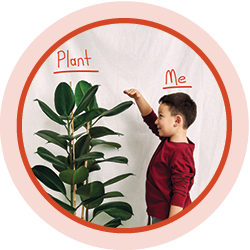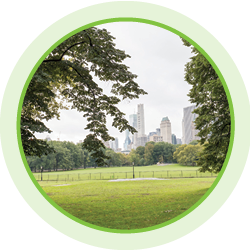 Fifty multidisciplinary activities can be found inside PLT’s Explore Your Environment: K-8 Activity Guide, divided by grade band. Many activities also offer variations for doing the activity with a different grade level or audience.
Fifty multidisciplinary activities can be found inside PLT’s Explore Your Environment: K-8 Activity Guide, divided by grade band. Many activities also offer variations for doing the activity with a different grade level or audience.
Activities for Kindergarten-Grade 2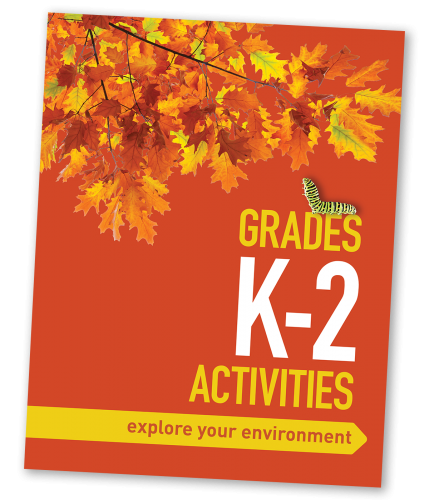
A Tree’s Life
Students discover that trees have life stages that are similar to those of other living things. They discuss a tree’s role in the ecosystem at each stage of its life.
Adopt a Tree
Students select individual trees to observe over time, deepening their awareness of tree changes and developing a greater appreciation for their local environment.
Backyard Safari
Every organism needs food, water, shelter, and space. A place that meets all these needs is called a habitat. Students will explore a nearby habitat—their backyard, schoolyard, or other outdoor settings—to look for signs of animals living there.
Birds and Bugs
Camouflage is an essential survival strategy in the natural world. Students discover the value of protective coloration as they pretend to be birds in search of colored bugs.
Bursting Buds
In early spring, many trees sprout bright green leaves. Where do the leaves come from? How do they form? Students investigate these questions by observing tree buds throughout the year.
Did You Notice?
Students observe differences over time to learn that change in the environment can occur quickly, slowly, or not at all.
Have Seeds, Will Travel
A plant is a biological system containing processes and components that enable it to grow and reproduce. By observing, collecting, and classifying seeds, students examine one aspect of a plant’s reproductive system.
Here We Grow Again
A plant is a biological system that needs sunlight, water, air, nutrients, and space in order to survive and thrive. Students conduct inquiry-based experiments to explore these essential plant requirements.
Make Your Own Paper
Students learn about the papermaking process by trying it themselves. Students will find out that they can make their own paper and that their product is practical, as well as beautiful.
Peppermint Beetle
Students explore their sense of smell and discover why smell is important to animals, including beetles and humans.
The Closer You Look
Even though students may be very familiar with trees, they may not have thought much about the actual structure of a tree. In this activity, your students will go outdoors or view pictures to take a closer look at trees and their parts.
Trees as Habitats
From their leafy branches to their tangled roots, trees provide habitat for a host of plants and animals. Students will inventory the plants and animals that live in, on, and around trees and discover how plants and animals depend on trees in many ways.
We All Need Trees
Students are often surprised to learn how many different products we get from trees. Use this activity to help students learn just how much we depend on trees in our daily lives.
Activities for Grades 3-5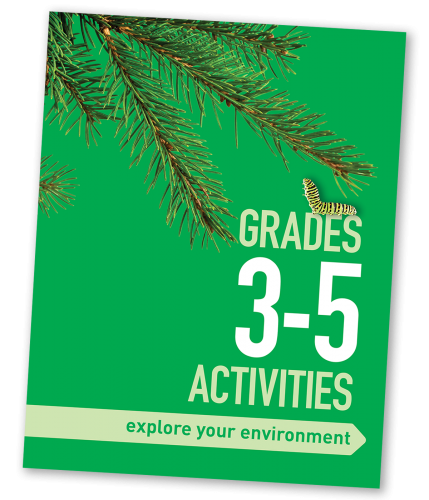
Charting Biodiversity

Students explore the amazing diversity of life on Earth and discover how plants and animals are adapted for survival. This activity helps students understand why there are so many different species and teaches them the value of biodiversity.
Discover Diversity
Students imagine that they are visitors from outer space, viewing life on Earth for the first time. By describing in minute detail all the life they find in a small plot of land, they will become more aware of the diversity and abundance of life on Earth and will better understand its importance.
Every Drop Counts
It’s easy to waste water and even easier to take water for granted. Water pours out of our faucets as though it were endlessly available. But the truth is that the supply of good quality, fresh water is limited. Fortunately, we can all conserve water instead of wasting it. This activity will help your group cut back on water waste.
Every Tree for Itself
This fun and active modeling simulation reviews the conditions that trees need to live and grow, while also demonstrating that trees must compete to meet their needs.
Fallen Log
It’s amazing how many things live in and on rotting logs. In this activity, your students will become familiar with some of those organisms by observing fallen logs or other decomposing pieces of wood. They’ll gain an understanding of how decomposition takes place and a better appreciation for microhabitats and communities.
Get Outside!
Regular and frequent time outdoors is beneficial for emotional, mental, and physical health, as well as for creativity, learning, and child development. In this activity, students will examine the physical and emotional effects of a task done outdoors versus indoors. They will design, plan, and carry out an investigation comparing the two settings, and analyze their results.

My Green Future
All kinds of people work in the forest—from foresters, to loggers, to scientists. Everyone depends on properly managed forests for recreation, essential products, wildlife and biodiversity, clean water and air. This activity provides students with an overview of forest-related careers.
Peek at Packaging
Nearly everything we buy comes in some sort of package. Students examine the pros and cons of different packaging and design an “ideal” package.
Poet-Tree
Writing and sharing poems gives students an opportunity to express their thoughts, feelings, and beliefs in creative and artistic ways. You can do this activity in combination with Adopt a Tree, to allow students to explore their adopted tree through poetry. You may also adapt the activity to explore parts of the environment other than trees and forests, such as art or architecture.
Signs of Fall
Students will look for signs of autumn and conduct an investigation to discover why the leaves of deciduous trees change color in the fall.
Soil Builders
Students explore differences in soil types and what those differences mean to people and to plants. They also investigate the role soil organisms play, both in building soil and in decomposition.
Tree Cookies
One way to learn about tree growth is to look at annual rings. Tree rings show patterns of change in the tree’s life, as well as changes in the area where it grows. Students will trace environmental and historical changes using a cross-section of a tree, or “tree cookie.”
Tree Factory
By modeling the parts of a tree and creating a “tree factory,” students will learn about the structure of a tree.
Tree ID
Tree species can be identified by looking at several different features: leaves, bark, twigs, flowers, fruit, and seeds. Even the overall shape of a tree can give clues to the tree’s identity. Students learn more about trees through these identifying features. Afterward, they can play an active game that tests their knowledge of different types of trees.
Trees for Many Reasons
By reading a story such as The Lorax by Dr. Seuss, students can examine the importance of conserving natural resources.
Trees in Trouble
Students examine trees for signs of damage or poor health and investigate conditions that may cause trees and other plants to become unhealthy.
Water Wonders
The water cycle is the system by which Earth’s water is collected, purified, and distributed from the environment to living things and then returned to the environment. Through modeling and an experiment, students explore the various steps of the water cycle and make connections between the water cycle and all living things.
Web of Life
By conducting research and modeling a food web, students take a close look at a forest ecosystem and discover ways that plants and animals are connected to one another. Although this activity focuses on forests, you can also use it to study other ecosystems, such as oceans, deserts, marshes, or prairies, by substituting the appropriate information.
Activities for Grades 6-8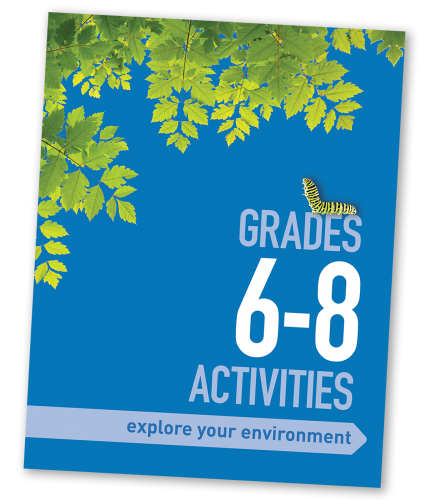
Decisions, Decisions

Decisions about community land use are complex and often involve many people in many ways. In this simulation, students use trees as a backdrop to develop a land-use plan.
Environmental Justice for All
Everyone has an equal right to a healthy environment—but does everyone have a healthy environment? In this activity, students propose actions to resolve various scenarios and then research issues related to environmental justice in their own state.
Exploration Energy!
The energy we use at home, school, or work enhances our lives, but it also often contributes to air and water pollution, wildlife and habitat loss, and climate change. When we reduce the amount of electricity we use—or use electricity from sources that are less polluting—we help to protect the environment and human health. Students learn about different sources of energy, conduct an audit of the electricity they use in their own homes, and create an action plan to use energy wisely.
Field, Forest, and Stream
Students conduct a field study of three different environments as they focus on sunlight, soil moisture, temperature, wind, water flow, plants, and animals in each environment. By comparing different environments, students will learn how nonliving elements influence living elements in an ecosystem.
Forest in the City
The trees in our communities provide many benefits: they improve air quality, store carbon, and conserve energy. Trees also enhance human health by reducing blood pressure, decreasing stress, and elevating attentiveness. Students conduct a survey to investigate the social and psychological effects of the urban forest.
Global Goods
Students gain an appreciation for how many natural resources they depend on in their day-to-day lives. By tracing the resources that go into making one item, students learn how its manufacturing can have an impact on the environment.
If You Were the Boss
Students play the role of forest manager for a 400-acre (162-hectare) public forest, exploring the complex factors that influence management decisions about forest lands.
Improve Your Place
Every living thing has a habitat—a place that meets its needs. Human beings’ habitat is the community in which they live. Students plan and, if possible, carry out a service-learning project that focuses on making positive environmental changes in their community.
Invasive Species
Throughout history, people have intentionally and unintentionally moved plant and animal species to new environments. Some of these species have proved beneficial, but others invade natural habitats, causing environmental and sometimes economic harm. Students research invasive species to determine how these species got to their new locations and what characteristics make their control so challenging.
Life on the Edge
Students model processes that can lead to species becoming rare or endangered. Then, they become advocates for rare or at-risk species of plants or animals and create “public relations campaigns” on behalf of these species.
Living with Fire
Students learn about the three elements a fire needs to burn and find out how this “fire triangle” can be used to prevent and manage wildland fires, particularly in the wildland–urban interface.
Nature’s Skyscrapers
Trees come in many shapes and sizes. Students become familiar with tree structure and scale by using different methods to measure them and by making comparisons. They learn the importance of standardized measurements and proper measuring techniques.
Nothing Succeeds Like Succession
Succession is a natural pattern of change that takes place over time in a forest or other ecosystem. Students read a story about succession and investigate the connections among plants, animals, and successional stages in a local ecosystem.
Our Federal Forests
Our nation’s forests are managed to support different outcomes. Students learn how forests can be managed to meet a variety of human and environmental needs and examine national parks or forests to identify challenges that forest managers face meeting different needs.
Plant a Tree
Never underestimate the power of a tree! In addition to giving us an amazing array of paper and wood products, trees provide a host of other benefits—from shading our backyards to reducing air pollution to helping stabilize the global climate. Students can express their appreciation of trees by planning and carrying out their own tree-planting project.
Reduce, Reuse, Recycle
By examining trash, students can learn a lot about how and why they throw things away. Students find ways to reduce their community’s waste production and improve its management through participation in a service-learning project.
Renewable or Not
Students model what happens to renewable and nonrenewable resources over time and discover why sustainable use of natural resources is so important.
The Global Climate
Using data collected from Mauna Loa, students graph changes in atmospheric levels of carbon dioxide (CO2) over the course of several decades and identify possible reasons for those changes. They will also explore the relationship among CO2, the Earth’s climate, and local ecosystems and suggest ways to reduce the effects of increased CO2 levels in the atmosphere.
What’s in a Label?
Students explore the environmental, social, and economic criteria of forest certification and consider possible benefits and limitations of certification for both forests and people. They then examine the steps involved in making a certified forest product and the importance of certifying each step of the process.
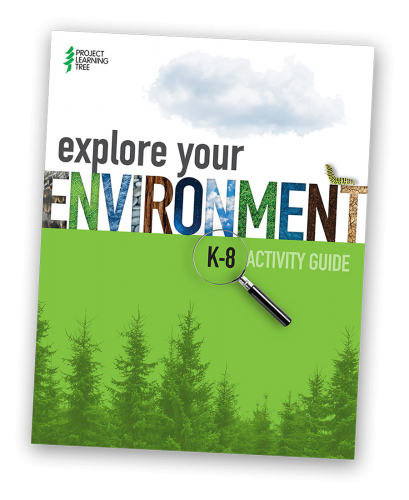 Get the Materials
Get the Materials
Purchase PLT’s Explore Your Environment: K-8 Activity Guide from Shop.PLT.org, Amazon, and other places where books are sold.
Or, find out about training opportunities in your state. State PLT programs offer in-person and virtual professional development. Through these interactive (and fun) workshops, participants can receive a print or online copy of Explore Your Environment and practice how to use PLT materials while also gaining insights from the facilitator and each other related to content and teaching strategies.


